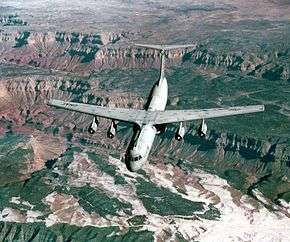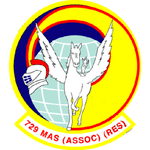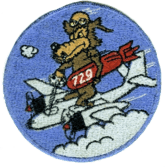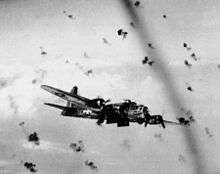729th Airlift Squadron
729th Airlift Squadron
 | |
|---|---|
 Squadron C-141B Starlifter over the Grand Canyon in 1998 | |
| Active | 1943–1945; 1947–1952; 1952–present |
| Country | United States |
| Branch |
|
| Role | Airlift |
| Part of | Air Force Reserve Command |
| Garrison/HQ | March Air Reserve Base |
| Engagements |
European Theater of Operations Korean War |
| Decorations |
Distinguished Unit Citation Air Force Outstanding Unit Award Republic of Korea Presidential Unit Citation Republic of Vietnam Gallantry Cross with Palm[1] |
| Insignia | |
| 729th Airlift Squadron emblem (modified 2 May 1995)[1] |
 |
| 729th Military Airlift Sq emblem (approved 29 April 1980)[1] |
 |
| 729th Bombardment Squadron emblem (approved 1 October 1943)[2] |
 |
| Aircraft flown | |
| Transport | C-17 Globemaster III |
The 729th Airlift Squadron is a United States Air Force Reserve squadron, assigned to the 452d Operations Group, stationed at March Joint Air Reserve Base, California. It operates C-17 Globemaster III aircraft providing global airlift any time, any place.
World War II

The squadron was first activated in June 1943 at Geiger Field, Washington as one of the four original squadrons of the 452d Bombardment Group. Later that month, it moved to Rapid City Army Air Base, South Dakota and began to train with the Boeing B-17 Flying Fortress. It continued training with Second Air Force until December, when it began its movement to the European Theater of Operations.[1][3] The ground echelon staged through Camp Shanks and sailed on the RMS Queen Elizabeth on 2 January 1944. The air echelon deployed via the South Atlantic air ferry route[4]
The squadron established itself at RAF Deopham Green in January 1944, and began operations on 4 February 1944 with a strike on an aircraft assembly plant near Brunswick. Its strategic targets included railroad marshalling yards near Frankfurt, aircraft factories near Regensberg and Kassel. the ball bearing factory at Schweinfurt and an oil refinery near Bohlen.[3] In September 1944, the squadron participated in the third shuttle mission, striking Chemnitz before landing in bases in the Soviet Union.[5]
The 729th was occasionally diverted to support tactical operations. It hit airfields, V-weapon launching sites, bridges and other objectives in preparations for Operation Overlord, the invasion of Normandy. It bombed enemy positions to support Operation Cobra, the breakout at Saint Lo in July 1944 and the attacks on Brest, France in August. It supported Operation Market Garden, airborne attacks in the Netherlands in September and, during the Battle of the Bulge, struck German lines of communication. It struck an airfield to support Operation Varsity, the airborne assault across the Rhine.[3]
Shortly before the end of the war, on 7 April, the squadron struck the jet fighter base at Kaltenkirchen, pressing the attack despite strong fighter opposition, earning a Distinguished Unit Citation. It flew its last mission of the war on 21 April against marshalling yards at Ingolstadt.[3]
After V-E Day, in August 1945, the squadron returned to the United States (the ground echelon once again sailed on the RMS Queen Elizabeth)[4] and was inactivated at Sioux Falls Army Air Field, South Dakota.[1]
Reserve duty and Korean War call-up
_Korea_May1951.jpg)
The squadron was reactivated in the reserve at Long Beach Army Air Field, California in 1947 as a very heavy bomber squadron, but conducted proficiency flying with a variety of trainer airplanes under the supervision of the 416th AAF Base Unit (later the 2347th Air Force Reserve Training Center).[6][7] In a 1949 reorganization of the reserves, it became a light bomber squadron and began to equip and train with Douglas B-26 Invaders.[note 1] The squadron was manned at only 25% of its authorized strength.[8]
The squadron was mobilized for the Korean War in August 1950 in the first wave of reserve mobilizations. To help bring it up to strength, the squadron was augmented by reservists assigned to the 448th Bombardment Wing, which was also stationed at Long Beach, but remained in reserve status until the following year.[9] The 729th was a squadron of one of the first two reserve wings to be mobilized,[note 2] and administrative provisions for mobilization proved inadequate, with numerous reservists never receiving the telegrams calling them to active duty.[10]
The unit moved to George Air Force Base, California for intensive training and to be brought up to full strength. In October, the squadron deployed to Itazuke Air Base, Japan to begin combat operations.[1] It entered combat two days later, depending on support from organizations already in theater and not waiting for support from the 452d Wing's ground echelon, which arrived by ship in November.[11] The squadron operated from Japan and later from the southern tip of Korea. The squadron flew armed reconnaissance, intruder and interdiction missions. It supported ground troops and attacked tactical targets.[3]
On 23 March 1951, the squadron led troop carrier aircraft carrying the 187th Airborne Infantry Regiment in an aerial assault on Munsan-ni, strafing the front lines of the Chinese Communist Forces and dropping bombs on enemy targets.[11] Prior to June 1951, the squadron had been conducting strikes primarily in the daytime. However, due to the extent of enemy night movements, after June, the 729th focused on night operations.[12] In May 1952, the squadron was inactivated and returned to the reserve. Its mission, personnel and aircraft were transferred to the 37th Bombardment Squadron, which was simultaneously activated at Pusan East (K-9) Air Base, South Korea.[1][13]
Reconnaissance and Bombardment in the reserves
The squadron was redesignated the 729th Tactical Reconnaissance Squadron and activated in June 1952 at Long Beach, where it absorbed some of the resources of the 921st Reserve Training Wing, which was inactivated. The reserve mobilization for the Korean War, however, had left the reserve without aircraft, and the unit did not receive aircraft until July 1952.[14] Despite its tactical reconnaissance name, it was first equipped with Curtiss C-46 Commando transports. The following year, it began to equip with a mix of aircraft, including The B-26 and North American F-51 Mustang. In 1954 it received its first jets, Lockheed F-80 Shooting Stars.[1][15]
In 1955, the squadron once again became the 729th Bombardment Squadron and trained with the Invader as a tactical bombardment unit.[15] However, at this time, the Joint Chiefs of Staff were pressuring the Air Force to provide more wartime airlift. At the same time, about 150 Fairchild C-119 Flying Boxcars became available from the active force. Consequently, in November 1956 the Air Force directed ConAC to convert units to the troop carrier mission by September 1957.[16] In July 1957, the squadron became the 729th Troop Carrier Squadrom.[1]
Activation of groups under the wing
Since 1955, the Air Force had been detaching Air Force Reserve squadrons from their parent wing locations to separate sites. The concept offered several advantages: communities were more likely to accept the smaller squadrons than the large wings and the location of separate squadrons in smaller population centers would facilitate recruiting and manning. In time, the detached squadron program proved successful in attracting additional participants.[17] Although the dispersal of flying units was not a problem when the entire wing was called to active service, mobilizing a single flying squadron and elements to support it proved difficult. This weakness was demonstrated in the partial mobilization of reserve units during the Berlin Crisis of 1961. To resolve this, at the start of 1962, ConAC determined to reorganize its reserve wings by establishing groups with support elements for each of its troop carrier squadrons. This reorganization would facilitate mobilization of elements of wings in various combinations when needed. However, as this plan was entering its implementation phase, another partial mobilization occurred for the Cuban Missile Crisis.[18] The formation of new troop carrier groups was delayed until January for wings that had not been mobilized.[18] The 943d Troop Carrier Group was formed at March on 17 January as the headquarters for the 729th and its supporting units.[15][1]
Reserve airlift
It has airlifted personnel and cargo worldwide since 1960. Missions the 729th has flown included humanitarian relief, aeromedical flights, and airdrops of supplies and paratroopers.
Lineage
- Constituted as the 729th Bombardment Squadron (Heavy) on 14 May 1943
- Activated on 1 June 1943
- Redesignated 729th Bombardment Squadron, Heavy on 20 August 1943
- Inactivated on 28 August 1945
- Redesignated 729th Bombardment Squadron, Very Heavy on 13 May 1947
- Activated in the reserve on 12 July 1947
- Redesignated 729th Bombardment Squadron, Light on 27 June 1949
- Ordered to active service on 10 August 1950
- Redesignated 729th Bombardment Squadron, Light, Night Intruder on 25 June 1951
- Relieved from active service and inactivated, on 10 May 1952
- Redesignated 729th Tactical Reconnaissance Squadron on 6 June 1952
- Activated in the reserve on 13 June 1952
- Redesignated: 729th Bombardment Squadron, Tactical on 22 May 1955
- Redesignated: 729th Troop Carrier Squadron, Medium on 1 July 1957
- Redesignated: 729th Tactical Airlift Squadron on 1 July 1967
- Redesignated: 729th Military Airlift Squadron (Associate) on 25 April 1969
- Redesignated: 729th Airlift Squadron (Associate) on 1 February 1992
- Redesignated: 729th Airlift Squadron on 1 April 1993[1]
Assignments
- 452d Bombardment Group, 1 June 1943 – 28 August 1945
- 452d Bombardment Group, 12 July 1947 – 10 May 1952
- 452d Tactical Reconnaissance Group (later 452d Bombardment Group, 452d Troop Carrier Group), 13 June 1952
- 452d Troop Carrier Wing, 14 April 1959
- 943d Troop Carrier Group (later 943 Tactical Airlift Group), 17 Januqry 1963
- 944th Military Airlift Group, 25 April 1969
- 445th Military Airlift Wing, 1 July 1973
- 445th Operations Group, 1 August 1992
- 452d Operations Group, 1 May 1994 – present[1]
Stations
|
|
Aircraft
|
|
References
- Notes
- ↑ Endicott indicates the training began in 1949. Robertson, Factsheet 729 Airlift Squadron. Maurer, however, indicates that B-26 training did not begin until 1950. Maurer, Combat Squadrons, p. 725
- ↑ The other was the 437th Troop Carrier Wing.
- Citations
- 1 2 3 4 5 6 7 8 9 10 11 12 13 14 Robertson, Patsy (26 November 2012). "Factsheet 729 Airlift Squadron (AFRC)". Air Force Historical Research Agency. Retrieved 23 October 2016.
- ↑ Maurer, Combat Squadrons, pp. 724–725
- 1 2 3 4 5 Maurer, Combat Units, pp. 326-328
- 1 2 Freeman, p. 258
- ↑ Freeman, p. 188
- ↑ "Abstract, History 416 AAF Base Unit Jan-Mar 1945". Air Force History Index. Retrieved May 7, 2017.
- ↑ "Abstract, History 2347 Air Force Reserve Training Center Jul-Sep 1950". Air Force History Index. Retrieved May 7, 2017.
- ↑ Cantwell, p. 74
- ↑ Cantwell, p. 92, Maurer, Combat Units, pp. 522-523
- ↑ Cantwell, p. 93
- 1 2 Endicott, pp. 69-70
- ↑ Cantwell, p. 103
- ↑ See Maurer, Combat Squadrons, p. 175 (simultaneous activation at Pusan)
- ↑ Cantwell, p. 139
- 1 2 3 Endicott, Judy G. (28 December 2007). "Factsheet 452 Air Mobility Wing (AFRC)". Air Force Historical Research Agency. Archived from the original on 3 March 2016. Retrieved May 30, 2016.
- ↑ Cantwell, p. 168
- ↑ Cantwell, p. 156
- 1 2 Cantwell, pp. 189-191
Bibliography
![]()
- Anderson, Capt. Barry (1985). Army Air Forces Stations: A Guide to the Stations Where U.S. Army Air Forces Personnel Served in the United Kingdom During World War II (PDF). Maxwell AFB, AL: Research Division, USAF Historical Research Center. Archived from the original (PDF) on 23 January 2016. Retrieved 7 July 2012.
- Cantwell, Gerald T. (1997). Citizen Airmen: a History of the Air Force Reserve, 1946-1994 (PDF). Washington, D.C.: Air Force History and Museums Program. ISBN 0-16049-269-6. Retrieved December 17, 2016.
- Endicott, Judy G., ed. (2001). The USAF in Korea, Campaigns, Units and Stations 1950-1953 (PDF). Maxwell AFB, AL: Air Force Historical Research Agency. ISBN 0-16-050901-7. Retrieved December 17, 2016.
- Freeman, Roger A. (1970). The Mighty Eighth: Units, Men and Machines (A History of the US 8th Army Air Force). London, England, UK: Macdonald and Company. ISBN 978-0-87938-638-2.
- Maurer, Maurer, ed. (1983) [1961]. Air Force Combat Units of World War II (PDF) (reprint ed.). Washington, DC: Office of Air Force History. ISBN 0-912799-02-1. LCCN 61060979.
- Maurer, Maurer, ed. (1982) [1969]. Combat Squadrons of the Air Force, World War II (PDF) (reprint ed.). Washington, DC: Office of Air Force History. ISBN 0-405-12194-6. LCCN 70605402. OCLC 72556.
- Ravenstein, Charles A. (1984). Air Force Combat Wings, Lineage & Honors Histories 1947-1977 (PDF). Washington, DC: Office of Air Force History. ISBN 0-912799-12-9.
- Watkins, Robert (2008). Battle Colors: Insignia and Markings of the Eighth Air Force In World War II. Vol I (VIII) Bomber Command. Atglen, PA: Shiffer Publishing Ltd. ISBN 0-7643-1987-6.
